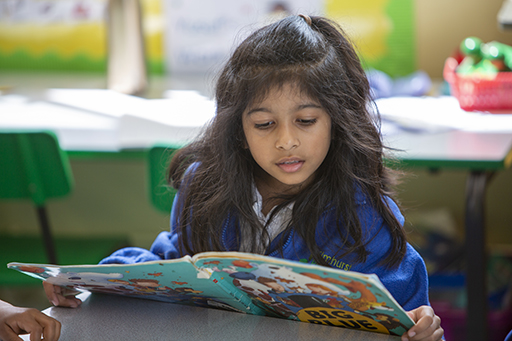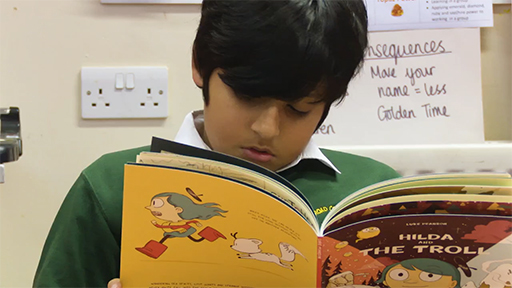5 Supporting reading time
Reading time has multiple titles: Everybody reading in class (ERIC), Uninterrupted silent sustained reading time (USSR), Sustained quiet uninterrupted individual reading time (SQUIRT) and Drop everything and read (DEAR). Whatever you call it, it is misleading to suggest that it is ever fully independent as ongoing support is needed to help children make informed choices, engage as readers, develop their stamina and perseverance, and participate in related informal conversations. Reading time, like all the RfP pedagogies needs to be Learner-led, Informal, Social and with Texts that Tempt (LIST).

Learner-led reading time
Learner-led reading time will develop by giving children options. This might include the chance to choose:
- what to read (online or in print)
- where to sit
- who to sit alongside
- to talk about what they’re reading
- to remain silent and read alone
- to swap their book or magazine for another
- to seek teacher support for making a new choice
- to read to or with others
- to engage in book related play.
Informal reading time
Children who don’t choose to read at home may not associate reading with relaxing, and a few cushions in the book corner will not solve this. Allow children choices and keep the tenor relaxed. Teacher participation – perhaps through discussing a book with small groups, reading themselves, offering a model of an adult engaged reader and supporting children’s choices – is also important. Occasional stories and hot chocolate time, creating dens complete with torches and blankets, and moving reading opportunities outdoors can also help as they make reading time special and overtly shared.
Social reading time
Conversations about what children are reading can be included at the start or end of a more silent reading session and may also develop spontaneously during it. In the earlier years, children may choose to retell a story, alone or with others, by acting it out, using soft toys, turning the pages and re-voicing the narrative. They may even be invited to use specific reading strategies, but too overt a focus on strategies can constrain children’s engagement and divert the purpose of the activity to skill development rather than nurturing choice-led reading.
Texts that tempt
Children need help to develop and exercise their discrimination as readers and find books that satisfy, surprise and sometimes stretch them. Friends’ recommendations help and teachers’ knowledge of children’s texts and of individual learners, as was argued in Session 4, is also critical. Children’s choice of texts that tempt them as readers is key, as the video in Activity 4 demonstrates.
Activity 3 The pedagogy checkLIST in action during reading time
Watch this video of Becky Thomson and her class of 10-11-year-olds during enriched reading time.

Transcript: Video 2
[INTERPOSING VOICES]
[INTERPOSING VOICES]
[INTERPOSING VOICES]
Now you have watched the video, reflect on the following questions.
- What kinds of activity did the children participate in during this time?
- What range of text choices were evident?
- How engaged were the children?
- What opportunities for motivated engagement and talk developed?
- What was Becky’s role prior to and during this time?
Comment
In Video 2, Becky offers a range of activities to nurture the children’s engagement. Teachers do not need to insist on silence, although setting some time aside or a space in the room for relatively quiet, sustained reading is invaluable.
Children can only make choices from what is available. So, classroom collections, the teacher’s mini-library and the school library all need attention to ensure breadth. In the early years, a core set of texts enriched by others offers support.
In the video, Becky joins a group to facilitate children’s informal book talk, and their engagement and motivation, but does not dominate. The noticing teacher will be aware of off-task talk and those children who do not settle to read and will offer additional focused support.
The teacher’s role involves ensuring their pedagogy is LIST, modelling their commitment and pleasure in reading, sharing their repertoire and establishing a supportive classroom environment in which relaxed book blether emerges naturally. You can learn more about this in the next section.

Optional resource
For more ideas and strategies to refine and shape reading time for RfP [Tip: hold Ctrl and click a link to open it in a new tab. (Hide tip)] visit The Open University’s Reading for Pleasure website.
